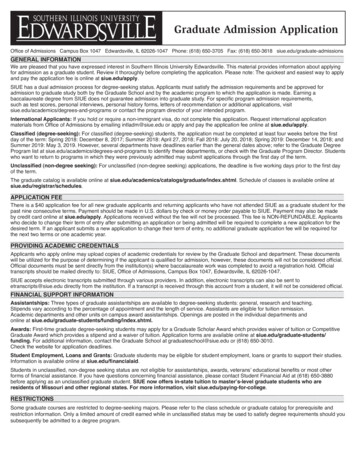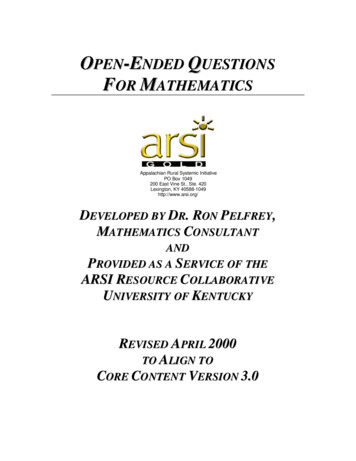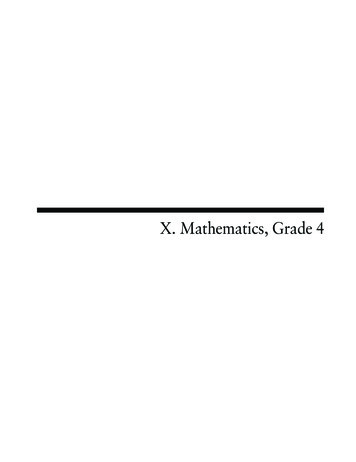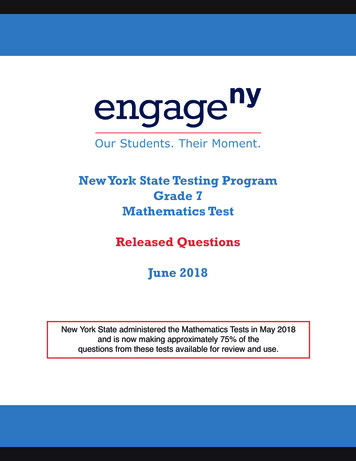
Transcription
BDRAMathematicsContent Standardsfor CaliforniaPublic SchoolsKindergarten ThroughGrade TwelveOO FEDAdopted by theCalifornia State Boardof EducationDecember, 1997California Department of EducationCreated May 18, 2000U
MathematicsContent Standardsfor CaliforniaPublic SchoolsKindergarten ThroughGrade TwelveCalifornia Department of EducationCreated May 18, 2000
EDUTENSTAIADEPAROFNT IOCATENTMOFC A LIFORPublishing InformationWhen the Mathematics Content Standards for California Public Schools, Kindergarten ThroughGrade Twelve was adopted by the California State Board of Education on December 11, 1997,the members of the State Board were the following: Yvonne W. Larsen, President; Jerry Hume,Vice-President; Kathryn Dronenburg; Marion Joseph; Megan Kephart; S. William Malkasian;Marion McDowell; Janet G. Nicholas; Gerti B. Thomas; Robert L. Trigg; and Marina Tse.This publication was edited by Faye Ong, working in cooperation with Bill Lucia, ExecutiveDirector, and Kimberly Yee, Program and Policy Analyst, State Board of Education. It wasdesigned and prepared for printing by the staff of CDE Press, with the cover and interior designcreated and prepared by Cheryl McDonald. Typesetting was done by Gloria Barreiro and CareyJohnson. It was published by the Department of Education, 721 Capitol Mall, Sacramento,California (mailing address: P.O. Box 944272, Sacramento, CA 94244-2720). It was distributedunder the provisions of the Library Distribution Act and Government Code Section 11096. 1999 by the California Department of EducationAll rights reservedISBN 0-8011-1457-8Special AcknowledgmentThe State Board of Education acknowledges the members and staff of the Commission for theEstablishment of Academic Content and Performance Standards (Academic Standards Commis sion) for their work in developing and recommending a draft of the Mathematics ContentStandards for California Public Schools to the State Board of Education under the provisionsof Education Code Section 60605.The members and staff of the Academic Standards Commission at the time of the approval of thedraft mathematics content standards were the following:Ellen Wright, Chair*; Bob Calfee, Vice Chair; Joseph Carrabino*; Judy Codding*; DanielCondron*; John D’Amelio; Linda Davis*; Bill Evers*; Andrew Galef*; Jerilyn Harris*; DorothyJue Lee; Mark Ortiz*; Judy Panton; Raymund Paredes; Alice Petrossian; Kate Simpson; LawrenceSiskind; Larry Stupski*; Jerry Treadway; LaTanya Wright; Delaine Eastin, State Superintendentof Public Instruction; Sonia Hernandez, the Superintendent’s designee; and Scott Hill, ExecutiveDirector.Note: The asterisk (*) identifies those members who served on the Mathematics Committee of theAcademic Standards Commission.Special commendation is also extended to the leadership of Janet Nicholas and Robert L. Trigg,members of the State Board of Education; Sue Stickel, a member of the Curriculum Developmentand Supplemental Materials Commission; and internationally recognized mathematicians Drs.Gunar Carlsson, David Geary, R. James Milgram, Richard Askey, and H-H. Wu. Their serviceand contributions to the mathematics ad hoc committee deserve special recognition.Ordering InformationCopies of this publication are available for 8.50 each, plus shipping and handling charges.California residents are charged sales tax. Orders may be sent to CDE Press, Sales Office,California Department of Education, P.O. Box 271, Sacramento, CA 95812-0271; FAX (916)323-0823. See page 64 for a partial list of other educational resources available from theDepartment. In addition, an illustrated Educational Resources Catalog describing publications,videos, and other instructional media available from the Department can be obtained withoutcharge by writing to the address given above or by calling the Sales Office at (916) 445-1260.NoticeThe guidance in Mathematics Content Standards for California Public Schools is not bindingon local educational agencies or other entities. Except for the statutes, regulations, and courtdecisions that are referenced herein, the document is exemplary, and compliance with it is notmandatory. (See Education Code Section 33308.5.)California Department of EducationPrepared for publicationby CSEA members.Created May 18, 2000
ContentsA Message from the State Board of Education and the State Superintendentof Public Instruction . ivIntroduction . vKindergarten . 1Grade One . 4Grade Two . 7Grade Three . 11Grade Four . 15Grade Five . 20Grade Six . 24Grade Seven . 29Grades Eight Through Twelve: Introduction . 35Algebra I . 38Geometry . 42Algebra II . 44Trigonometry . 47Mathematical Analysis . 49Linear Algebra . 51Probability and Statistics . 53Advanced Placement Probability and Statistics . 54Calculus . 56Glossary . 60California Department of EducationCreated May 18, 2000
A Message from the State Board of Education and theState Superintendent of Public InstructionFifteen years ago the report A Nation at Risk,by the National Commission on Excellence inEducation (1983), brought squarely to ourattention a “rising tide of mediocrity” in ourschools. An era of education reform began. Theresults were somewhat uneven. The reformmovement did stimulate important infrastructureimprovements: instructional time was increased,high school diplomas came to signify the comple tion of minimum course requirements, andemphasis was placed on local planning efforts toimprove the schools’ efficiency and effectiveness.A shortcoming of the movement up to this pointhas been the lack of focus on rigorous academicstandards. The desire to improve studentachievement guided the effort, but it lacked acomprehensive, specific vision of what studentsactually needed to know and be able to do.Standards are a bold initiative.With the adoption of these content standardsin mathematics, California is going beyond reform.We are redefining the state’s role in publiceducation. For the first time, we are stating—explicitly—the content that students need toacquire at each grade level from kindergarten tograde twelve. These standards are rigorous. Withstudent mastery of this content, Californiaschools will be on a par with those in the besteducational systems in other states and nations.The content is attainable by all students, givensufficient time, except for those few who havesevere disabilities. We regard the standards asfirm but not unyielding; they will be modified infuture years to reflect new research and scholar ship.Standards describe what to teach,not how to teach it.Standards-based education maintainsCalifornia’s tradition of respect for local controlof schools. To help students achieve at highCalifornia Department of Educationlevels, local school officials and teachers—withthe full support and cooperation of families,businesses, and community partners—areencouraged to take these standards and designthe specific curricular and instructional strategiesthat best deliver the content to their students.Standards are an enduring commitment,not a passing fancy.Every initiative in public education, especiallyone so bold as establishing high standards, hasits skeptics. “Just wait a while,” they say, “stan dards, too, will pass.” We intend to prove theskeptics wrong, and we intend to do that bycompletely aligning state efforts to these stan dards, including the statewide testing program,curriculum frameworks, instructional materials,professional development, preservice education,and compliance review. We will see a generationof educators who think of standards not as a newlayer but as the foundation itself.Standards are our commitment to excellence.Fifteen years from now, we are convinced, theadoption of standards will be viewed as thesignal event that began a “rising tide of excel lence” in our schools. No more will the criticalquestion What should my child be learning? be metwith uncertainty of knowledge, purpose, orresolve. These standards answer the question.They are comprehensive and specific. Theyrepresent our commitment to excellence.YVONNE W. LARSEN, PresidentCalifornia State Board of EducationDELAINE EASTINState Superintendent of Public InstructionCreated May 18, 2000
IntroductionA high-quality mathematics program isessential for all students and provides everystudent with the opportunity to choose amongthe full range of future career paths. Mathemat ics, when taught well, is a subject of beauty andelegance, exciting in its logic and coherence. Ittrains the mind to be analytic—providing thefoundation for intelligent and precise thinking.To compete successfully in the worldwideeconomy, today’s students must have a highdegree of comprehension in mathematics. Fortoo long schools have suffered from the notionthat success in mathematics is the province of atalented few. Instead, a new expectation isneeded: all students will attain California’smathematics academic content standards, andmany will be inspired to achieve far beyond theminimum standards.These content standards establish what everystudent in California can and needs to learn inmathematics. They are comparable to thestandards of the most academically demandingnations, including Japan and Singapore—twohigh-performing countries in the Third Interna tional Mathematics and Science Study (TIMSS).Mathematics is critical for all students, not onlythose who will have careers that demandadvanced mathematical preparation but allcitizens who will be living in the twenty-firstcentury. These standards are based on thepremise that all students are capable of learningrigorous mathematics and learning it well, andall are capable of learning far more than iscurrently expected. Proficiency in most ofmathematics is not an innate characteristic; it isCalifornia Department of Educationachieved through persistence, effort, andpractice on the part of students and rigorousand effective instruction on the part of teachers.Parents and teachers must provide support andencouragement.The standards focus on essential content forall students and prepare students for the studyof advanced mathematics, science and technicalcareers, and postsecondary study in all contentareas. All students are required to grapple withsolving problems; develop abstract, analyticthinking skills; learn to deal effectively andcomfortably with variables and equations; anduse mathematical notation effectively to modelsituations. The goal in mathematics education isfor students to: Develop fluency in basic computationalskills. Develop an understanding of mathemati cal concepts. Become mathematical problem solverswho can recognize and solve routineproblems readily and can find ways toreach a solution or goal where no routinepath is apparent. Communicate precisely about quantities,logical relationships, and unknown valuesthrough the use of signs, symbols, models,graphs, and mathematical terms. Reason mathematically by gathering data,analyzing evidence, and building argu ments to support or refute hypotheses. Make connections among mathematicalideas and between mathematics and otherdisciplines.Created May 18, 2000
INTRODUCTIONThe standards identify what all students inCalifornia public schools should know and beable to do at each grade level. Nevertheless,local flexibility is maintained with these stan dards. Topics may be introduced and taught atone or two grade levels before mastery isexpected. Decisions about how best to teach thestandards are left to teachers, schools, andschool districts.The standards emphasize computational andprocedural skills, conceptual understanding,and problem solving. These three components ofmathematics instruction and learning are notseparate from each other; instead, they areintertwined and mutually reinforcing.Basic, or computational and procedural, skillsare those skills that all students should learn touse routinely and automatically. Studentsshould practice basic skills sufficiently andfrequently enough to commit them to memory.Mathematics makes sense to students whohave a conceptual understanding of the domain.They know not only how to apply skills but alsowhen to apply them and why they should applythem. They understand the structure and logicof mathematics and use the concepts flexibly,effectively, and appropriately. In seeing the bigpicture and in understanding the concepts, theyare in a stronger position to apply their knowl edge to situations and problems they may nothave encountered before and readily recognizewhen they have made procedural errors.The mathematical reasoning standards aredifferent from the other standards in that theydo not represent a content domain. Mathemati cal reasoning is involved in all strands.The standards do not specify how the curricu lum should be delivered. Teachers may usedirect instruction, explicit teaching, knowledgebased, discovery-learning, investigatory, inquiry-based, problem solving-based, guideddiscovery, set-theory-based, traditional, progres sive, or other methods to teach students thesubject matter set forth in these standards. AtCalifornia Department of Educationthe middle and high school levels, schools canuse the standards with an integrated program orwith the traditional course sequence of algebra I,geometry, algebra II, and so forth.Schools that utilize these standards “enroll”students in a mathematical apprenticeship inwhich they practice skills, solve problems, applymathematics to the real world, develop acapacity for abstract thinking, and ask andanswer questions involving numbers or equa tions. Students need to know basic formulas,understand what they mean and why theywork, and know when they should be applied.Students are also expected to struggle withthorny problems after learning to perform thesimpler calculations on which they are based.Teachers should guide students to thinkabout why mathematics works in addition tohow it works and should emphasize under standing of mathematical concepts as well asachievement of mathematical results. Studentsneed to recognize that the solution to any givenproblem may be determined by employing morethan one strategy and that the solution fre quently raises new questions of its own: Doesthe answer make sense? Are there other, moreefficient ways to arrive at the answer? Does theanswer bring up more questions? Can I answerthose? What other information do I need?Problem solving involves applying skills,understanding, and experiences to resolve newor perplexing situations. It challenges studentsto apply their understanding of mathematicalconcepts in a new or complex situation, toexercise their computational and proceduralskills, and to see mathematics as a way offinding answers to some of the problems thatoccur outside a classroom. Students grow intheir ability and persistence in problem solvingby extensive experience in solving problems at avariety of levels of difficulty and at every levelin their mathematical development.Problem solving, therefore, is an essentialpart of mathematics and is subsumed in everyCreated May 18, 2000
INTRODUCTIONstrand and in each of the disciplines in gradeseight through twelve. Problem solving is notseparate from content. Rather, students learnconcepts and skills in order to apply them tosolve problems in and outside school. Becauseproblem solving is distinct from a contentdomain, its elements are consistent across gradelevels.The problems that students solve must ad dress important mathematics. As studentsprogress from grade to grade, they should dealwith problems that (1) require increasingly moreadvanced knowledge and understanding ofmathematics; (2) are increasingly complex(applications and purely mathematical investiga tions); and (3) require increased use of inductiveand deductive reasoning and proof. In addition,problems should increasingly require students tomake connections among mathematical ideaswithin a discipline and across domains. Eachyear students need to solve problems from allstrands, although most of the problems shouldrelate to the mathematics that students study thatyear. A good problem is one that is mathemati cally important; specifies the problem to besolved but not the solution path; and draws upongrade-level appropriate skills and conceptualunderstanding.Organization of the StandardsThe mathematics content standards forkindergarten through grade seven are organizedby grade level and are presented in five strands:number sense; algebra and functions; measure ment and geometry; statistics, data analysis, andprobability; and mathematical reasoning. Focusstatements indicating the increasingly complexmathematical skills that will be required ofstudents from kindergarten through grade sevenare included at the beginning of each grade level;the statements indicate the ways in which thediscrete skills and concepts form a cohesivewhole.California Department of EducationThe standards for grades eight throughtwelve are organized differently from those forkindergarten through grade seven. Strands arenot used for organizational purposes becausethe mathematics studied in grades eight throughtwelve falls naturally under the disciplineheadings algebra, geometry, and so forth. Manyschools teach this material in traditional courses;others teach it in an integrated program. Toallow local educational agencies and teachersflexibility, the standards for grades eightthrough twelve do not mandate that a particulardiscipline be initiated and completed in a singlegrade. The content of these disciplines must becovered, and students enrolled in these disci plines are expected to achieve the standardsregardless of the sequence of the disciplines.Mathematics Standardsand TechnologyAs rigorous mathematics standards areimplemented for all students, the appropriaterole of technology in the standards must beclearly understood. The following consider ations may be used by schools and teachers toguide their decisions regarding mathematicsand technology:Students require a strong foundation in basicskills. Technology does not replace the need forall students to learn and master basic mathemat ics skills. All students must be able to add,subtract, multiply, and divide easily without theuse of calculators or other electronic tools. Inaddition, all students need direct work andpractice with the concepts and skills underlyingthe rigorous content described in the Mathemat ics Content Standards for California Public Schoolsso that they develop an understanding ofquantitative concepts and relationships. Thestudents’ use of technology must build on theseskills and understandings; it is not a substitutefor them.Created May 18, 2000
INTRODUCTIONTechnology should be used to promote mathemat ics learning. Technology can help promotestudents’ understanding of mathematicalconcepts, quantitative reasoning, and achieve ment when used as a tool for solving problems,testing conjectures, accessing data, and verifyingsolutions. When students use electronic tools,databases, programming language, and simula tions, they have opportunities to extend theircomprehension, reasoning, and problem-solvingskills beyond what is possible with traditionalprint resources. For example, graphing calcula tors allow students to see instantly the graphs ofcomplex functions and to explore the impact ofchanges. Computer-based geometry construc tion tools allow students to see figures in threedimensional space and experiment with theeffects of transformations. Spreadsheet pro grams and databases allow students to key indata and produce various graphs as well ascompile statistics. Students can determine themost appropriate ways to display data andquickly and easily make and test conjecturesabout the impact of change on the data set. Inaddition, students can exchange ideas and testhypotheses with a far wider audience throughthe Internet. Technology may also be used toreinforce basic skills through computer-assistedinstruction, tutoring systems, and drill-andpractice software.California Department of EducationThe focus must be on mathematics content. Thefocus must be on learning mathematics, usingtechnology as a tool rather than as an end initself. Technology makes more mathematicsaccessible and allows one to solve mathematicalproblems with speed and efficiency. However,technological tools cannot be used effectivelywithout an understanding of mathematicalskills, concepts, and relationships. As studentslearn to use electronic tools, they must alsodevelop the quantitative reasoning necessary tomake full use of those tools. They must alsohave opportunities to reinforce their estimationand mental math skills and the concept of placevalue so that they can quickly check theircalculations for reasonableness and accuracy.Technology is a powerful tool in mathemat ics. When used appropriately, technology mayhelp students develop the skills, knowledge, andinsight necessary to meet rigorous contentstandards in mathematics and make a successfultransition to the world beyond school. Thechallenge for educators, parents, andpolicymakers is to ensure that technologysupports, but is not a substitute for, the develop ment of quantitative reasoning and problemsolving skills.Created May 18, 2000
KINDERGARTEN 1KindergartenBy the end of kindergarten, students understand small numbers, quantities, andsimple shapes in their everyday environment. They count, compare, describe andsort objects, and develop a sense of properties and patterns.Number Sense1.0Students understand the relationship between numbers and quantities(i.e., that a set of objects has the same number of objects in different situationsregardless of its position or arrangement):1.1 Compare two or more sets of objects (up to ten objects in each group) andidentify which set is equal to, more than, or less than the other.1.2 Count, recognize, represent, name, and order a number of objects (up to 30).1.3 Know that the larger numbers describe sets with more objects in them than thesmaller numbers have.2.0Students understand and describe simple additions and subtractions:2.1 Use concrete objects to determine the answers to addition and subtractionproblems (for two numbers that are each less than 10).3.0Students use estimation strategies in computation and problem solving thatinvolve numbers that use the ones and tens places:3.1 Recognize when an estimate is reasonable.1California Department of EducationCreated May 18, 2000
2KINDERGARTENAlgebra and Functions1.0Students sort and classify objects:1.1 Identify, sort, and classify objects by attribute and identify objects that do notbelong to a particular group (e.g., all these balls are green, those are red).Measurement and Geometry1.0Students understand the concept of time and units to measure it; they under stand that objects have properties, such as length, weight, and capacity, andthat comparisons may be made by referring to those properties:1.1 Compare the length, weight, and capacity of objects by making direct comparisonswith reference objects (e.g., note which object is shorter, longer, taller, lighter,heavier, or holds more).1.2 Demonstrate an understanding of concepts of time (e.g., morning, afternoon,evening, today, yesterday, tomorrow, week, year) and tools that measure time(e.g., clock, calendar).1.3 Name the days of the week.1.4 Identify the time (to the nearest hour) of everyday events (e.g., lunch time is12 o’clock; bedtime is 8 o’clock at night).2.0Students identify common objects in their environment and describe thegeometric features:2.1 Identify and describe common geometric objects (e.g., circle, triangle, square,rectangle, cube, sphere, cone).2.2 Compare familiar plane and solid objects by common attributes (e.g., position,shape, size, roundness, number of corners).California Department of EducationCreated May 18, 2000
KINDERGARTEN 3Statistics, Data Analysis, and Probability1.0Students collect information about objects and events in their environment:1.1 Pose information questions; collect data; and record the results using objects,pictures, and picture graphs.1.2 Identify, describe, and extend simple patterns (such as circles or triangles) byreferring to their shapes, sizes, or colors.Mathematical Reasoning1.0Students make decisions about how to set up a problem:1.1 Determine the approach, materials, and strategies to be used.1.2 Use tools and strategies, such as manipulatives or sketches, to model problems.2.0Students solve problems in reasonable ways and justify their reasoning:2.1 Explain the reasoning used with concrete objects and/or pictorial representations.2.2 Make precise calculations and check the validity of the results in the context of theproblem.California Department of EducationCreated May 18, 2000
4GRADE ONEGrade OneBy the end of grade one, students understand and use the concept of ones andtens in the place value number system. Students add and subtract small numberswith ease. They measure with simple units and locate objects in space. Theydescribe data and analyze and solve simple problems.Number Sense1.0Students understand and use numbers up to 100:1.1 Count, read, and write whole numbers to 100.1.2 Compare and order whole numbers to 100 by using the symbols for less than, equalto, or greater than ( , , ).1.3 Represent equivalent forms of the same number through the use of physical mod els, diagrams, and number expressions (to 20) (e.g., 8 may be represented as 4 4,5 3, 2 2 2 2, 10 2, 11 3).1.4 Count and group object in ones and tens (e.g., three groups of 10 and 4 equals 34,or 30 4).1.5 Identify and know the value of coins and show different combinations of coins thatequal the same value.2.0Students demonstrate the meaning of addition and subtraction and use theseoperations to solve problems:2.1 Know the addition facts (sums to 20) and the corresponding subtraction facts andcommit them to memory.2.2 Use the inverse relationship between addition and subtraction to solve problems.2.3 Identify one more than, one less than, 10 more than, and 10 less than a givennumber.2.4 Count by 2s, 5s, and 10s to 100.2.5 Show the meaning of addition (putting together, increasing) and subtraction(taking away, comparing, finding the difference).4California Department of EducationCreated May 18, 2000
GRADE ONE 52.6 Solve addition and subtraction problems with one- and two-digit numbers(e.g., 5 58 ).2.7 Find the sum of three one-digit numbers.3.0Students use estimation strategies in computation and problem solving thatinvolve numbers that use the ones, tens, and hundreds places:3.1 Make reasonable estimates when comparing larger or smaller numbers.Algebra and Functions1.0Students use number sentences with operational symbols and expressions tosolve problems:1.1 Write and solve number sentences from problem situations that express relation ships involving addition and subtraction.1.2 Understand the meaning of the symbols , , .1.3 Create problem situations that might lead to given number sentences involvingaddition and subtraction.Measurement and Geometry1.0Students use direct comparison and nonstandard units to describe the mea surements of objects:1.1 Compare the length, weight, and volume of two or more objects by using directcomparison or a nonstandard unit.1.2 Tell time to the nearest half hour and relate
use mathematical notation effectively to model situations. The goal in mathematics education is for students to: Develop fluency in basic computational skills. Develop an understanding of mathemati cal concepts. Become mathematical problem solvers who can recognize and solve routine problems readily and can find ways to











